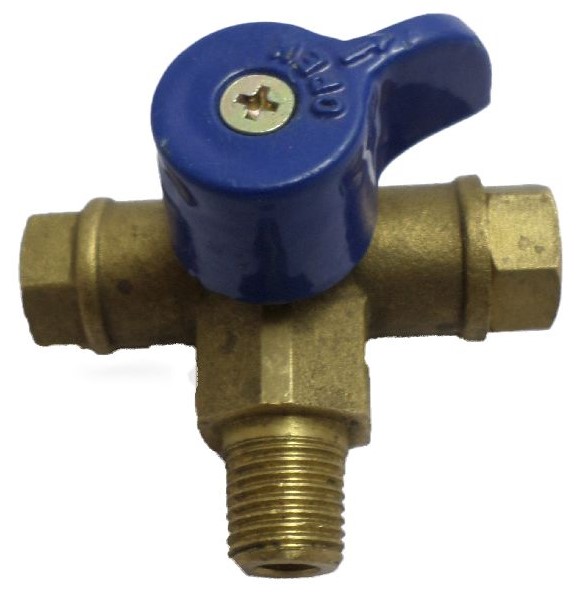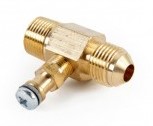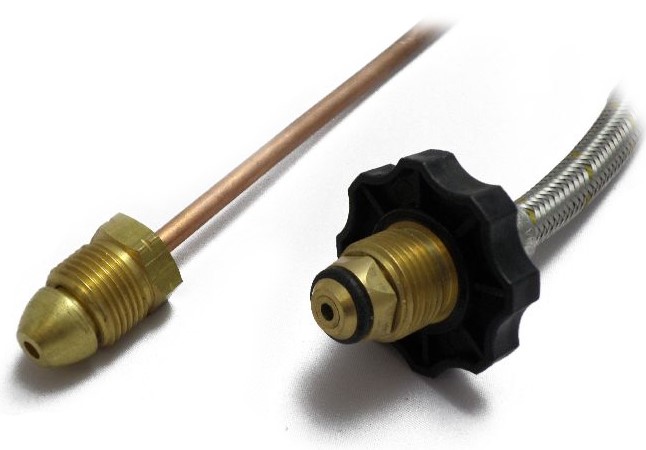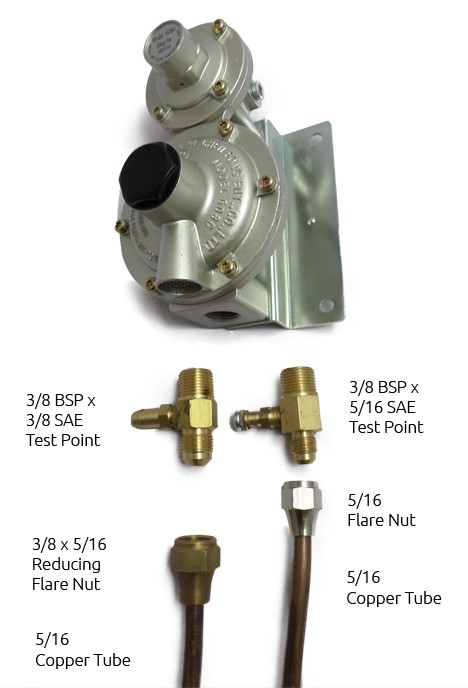Here is your complete guide to caravan gas regulators in Australia.
Your caravan gas regulator and pig tails require regular inspection, maintenance and replacement. You can replace most of these parts yourself, providing you are replacing with the same items.
About Caravan Gas Pressures
Your caravan's entire gas system runs on "low pressure", as all appliances are connected through a regulator. This is as opposed to a "high pressure" gas system which is common in many camping/tenting setups - like where you run a gas light or gas cooker (e.g. Primus type cooker) directly from a gas bottle. These "high pressure" appliances tend to be noisy - you can hear the high pressure gas sound while the appliance is running. It is for this reason, that you can't easily connect a Primus type cooker (which is high pressure) to your caravan gas system (which is low pressure).
Any appliance with a regulator is a "low pressure" appliance. E.g. your home BBQ that normally comes with a hose and inline regulator is "low pressure" and could run from your caravan gas supply. This is the case for some portable BBQs like the Weber Baby Q which is very popular.
Regulators

Caravan gas regulators sit between the gas bottles and the rest of your caravan's gas system. They control the gas pressure supplied to all appliances and are generally set to run at 2.8 kPa. There is little to no maintenance you can do on a regulator, however, they do deteriorate over time. Deterioration is normally caused by poor gas quality from the bottles, water getting into the lines (due to leaks in pipes or pig tails) and travelling into the regulator, or the pig tail lining deteriorating and clogging up the regulator. When a regulator fails, the easiest solution is to replace the regulator. You should also consider replacing pig tails at the same time, and potentially the gas bottles too - so you avoid the same issue happening again.
It is now a legal requirement that all caravans use a two-stage regulator. Some older caravans may still be fitted with a single-stage regulator. These older vans will require their regulator upgraded to a two-stage type in order to pass a gas certificate inspection if the unit is sold.
Pig Tails
Pig tails are the hoses or pipes that connect the gas bottle to the regulator. There are 3 basic types of pig tails:
 Copper
Copper
Cheap and simple. Copper will not deteriorate, but they are difficult to use. You need to flex the pipe each time you connect/disconnect a bottle, and over time this will cause them to break or kink
 Stainless Steel over Rubber
Stainless Steel over Rubber
Most popular choice. Easier to connect/disconnect than the copper type. However, the internal rubber hose can deteriorate (especially with certain gas types) and clog the regulator.
 S-Core
S-Core
Highest quality. Corrugated stainless steel internal hose, covered in braided stainless steel, covered in yellow PVC cover. Available with a "hand wheel" that allows you to easy connect/disconnect bottles with no spanners required. (Now mandatory in WA)
Pig Tail Connections
The end that connects to the gas bottle is called a "POL" fitting. ("Prest-O-Lite" was the company that first produced these type of gas valves). Most of these fittings require a spanner to tighten/loosen the fitting on the gas bottle. Higher quality pig tails include a "hand wheel" which allows you to tighten/loosen the connection without a spanner - and make life on the road just that little bit easier! All POL fittings are a "left-hand" thread. This means that it is reverse to normal - you turn anti-clockwise to tighten, and clockwise to loosen. Older POL connections used a metal-on-metal connection for sealing. These days, most POL fittings include a rubber O-ring to further improve the seal. The downside is that these can easily become damaged or deteriorate over time - so they need to be checked regularly. You should always test the connection to the gas bottle with soapy water after every reconnection.
LEFT: Copper pig tail with POL fitting with NO O-ring
RIGHT: Stainless steel pig tail with POL fitting, hand wheel and O-ring
The other end of the pig tail connects to the regulator. There are two common sizes:
IMAGE
- 1/4" Inverted Flare|
- Measures 10.5mm external diameter
- Normally used on dual bottle applications where pig tails go into a change-over tap first
- 1/4" NPT (National Pipe Thread)
- Measures 12.5mm external diameter|
- Normally used on single bottle applications where pig tail goes directly into regulator
- Requires sealing tape / liquid seal
Change Over Tap

These are used on dual gas bottle systems. They are a basic tap that turns 180-degrees to connect one bottle at a time to the regulator. They normally have a 1/4" NPT outlet which screws into the regulator, and 2x 1/4" Inverted Flare inputs for the pig tails from the gas bottles.
Test Point

A test point is connected to the outlet of the regulator, and allows easy testing of the pressure of the gas system with an appropriate meter. This is very useful for determining whether the system is leaking, and is now a legal requirement in some states. If you're upgrading your regulator, it is recommended that you fit one, as any future fault finding is made much easier.
Test points also act as a simple adaptor between the regulator output and the copper pipe.
This image shows you how to simply adapt from the regulator back to the system copper pipe size. Most caravans use 5/16" copper pipe. You need to match the flare nut on the copper tube to the outlet size of the test point. 3/8" copper tube is used on some caravans. In this case you would simply use a 3/8" flare nut, on a 3/8" tube.
 Caravan gas regulators sit between the gas bottles and the rest of your caravan's gas system. They control the gas pressure supplied to all appliances and are generally set to run at 2.8 kPa. There is little to no maintenance you can do on a regulator, however, they do deteriorate over time. Deterioration is normally caused by poor gas quality from the bottles, water getting into the lines (due to leaks in pipes or pig tails) and travelling into the regulator, or the pig tail lining deteriorating and clogging up the regulator. When a regulator fails, the easiest solution is to replace the regulator. You should also consider replacing pig tails at the same time, and potentially the gas bottles too - so you avoid the same issue happening again.
Caravan gas regulators sit between the gas bottles and the rest of your caravan's gas system. They control the gas pressure supplied to all appliances and are generally set to run at 2.8 kPa. There is little to no maintenance you can do on a regulator, however, they do deteriorate over time. Deterioration is normally caused by poor gas quality from the bottles, water getting into the lines (due to leaks in pipes or pig tails) and travelling into the regulator, or the pig tail lining deteriorating and clogging up the regulator. When a regulator fails, the easiest solution is to replace the regulator. You should also consider replacing pig tails at the same time, and potentially the gas bottles too - so you avoid the same issue happening again. Copper
Copper Stainless Steel over Rubber
Stainless Steel over Rubber S-Core
S-Core

 A test point is connected to the outlet of the regulator, and allows easy testing of the pressure of the gas system with an appropriate meter. This is very useful for determining whether the system is leaking, and is now a legal requirement in some states. If you're upgrading your regulator, it is recommended that you fit one, as any future fault finding is made much easier.
A test point is connected to the outlet of the regulator, and allows easy testing of the pressure of the gas system with an appropriate meter. This is very useful for determining whether the system is leaking, and is now a legal requirement in some states. If you're upgrading your regulator, it is recommended that you fit one, as any future fault finding is made much easier.